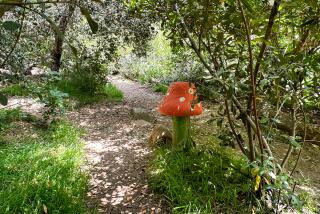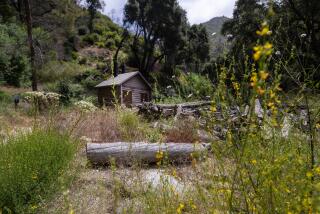Forest Researchers Thrive on Disaster
Most people think of forest fires, muds sides and air pollution as environmental disasters. But scientists at the San Dimas Experimental Forest, which stretches from the foothills to the timberline, think of them as opportunities.
It is somewhat natural that the scientists at the federal research enclave in Angeles National Forest think that way. Charles Colver, forest manager, said the original facility grew out of a devastating mountain fire in 1919; the research direction was beneficially altered by a fire in 1960, and smog damage to the forest in recent years has stimulated experimentation and yielded important findings about effects on plants, streams and ground water.
The experimental forest was dedicated 50 years ago, and Colver and others who have worked on science projects or helped construct buildings and clear trails gathered there this month to celebrate the achievements.
There are dozens of experimental forests across the country. What makes the San Dimas forest especially interesting to scientists is its proximity to urban life and the opportunity to measure urban impacts on it. The forest lies just above San Dimas, La Verne and Claremont, extending north to Glendora Ridge Road, a sort of crossroads of smog.
âWeâre in the greatest place on earth to study air pollution,â said Colver enthusiastically, at the same time bemoaning the damage smog is doing to plant life. Scientists have attributed the decline of conifers, such as firs and pines, to air pollutants attacking the foliage.
It was the 1960 wildfire, Colver said, that taught researchers that a calamity can be a blessing in disguise. The fire, touched off by lightning, blackened 15,000 acres, nearly the entire watershed.
âAt first blush, we all thought it was a disaster,â Colver said. âIt wiped out most of the facilities. We had a huge network of rain gauges and it ruined them. We were kind of wringing our hands, saying this looks like the end. The landscape looked like
the moon. . . . But our scientists said maybe this is the opportunity weâve been waiting for.â
The fire prompted the government to allocate more money to the forest for equipment and research, drew new scientists with fresh ideas to the area and produced a wealth of scientific data. Indeed, 25 years later, Colver said, scientific observations are still being made on that fireâs aftermath.
These days scientists donât have to wait for a disaster to study one. Theyâve learned to reproduce fire-flood cycles in miniature.
âWe can duplicate the effects of a 100-acre fire in 100 square feet,â said Wade Wells II, one of more than 25 researchers with projects in the experimental forest. Wells, a hydrologist based at the Forest Serviceâs fire research lab in Riverside, is particularly interested in erosion control.
Work at the San Dimas Experimental Forest has shown that erosion starts during a fire and proceeds rapidly, even before rains come, Wells said. By building an understanding of how erosion works, he said, scientists can determine what steps should be taken before and after a fire to minimize erosion loss.
Disaster Created, Studied
Scientists burned 200 acres of the forest last fall in a large-scale experiment to examine fire effects. The National Aeronautics and Space Administration participated in the experiment, flying equipment over two separate fires to measure heat intensity. After the fires, a system of overhead sprinklers and hoses produced artificial rainfall so scientists could observe the flow of mud and debris. Slopes were soaked to induce soil failures and the results were recorded on videotape.
Much of the research in the forest today involves air pollution. One study is investigating whether smog is responsible for the introduction of nitrates into ground water. Scientists theorize that smog particles settle on plants, are washed by rain into streams and seep into water supplies.
Another project involves measurement of acid rain. San Dimas Experimental Forest is one of a national network of 100 sites where rain is collected and sent to a lab at the University of Illinois for analysis. Buckets are used to collect not only rain but also the particles that settle out from morning dew. Here it is dew, rather than rainfall, that has the highest acid content, researchers say. The dew carries smog particles while rains from storms coming off the Pacific Ocean are comparatively acid-free.
It is Colverâs job as forest manager to see that the acid rain buckets are shipped to Illinois weekly, take care of other details on experiments and limit access to the forest to those who have a legitimate scientific or educational purpose. Colver said many universities, including UCLA, Caltech and the Claremont Colleges, have professors and graduate students conducting experiments in the forest and tours can be arranged other people. Casual visitors are not allowed to wander in unescorted.
Problems With Vandals
Colver said exclusion of the public does not pose a hardship because only 17,000 acres out of nearly 700,000 in Angeles National Forest are closed. Nevertheless, vandals and other intruders do find their way into the research area.
âSome people have the feeling that if itâs closed, we must have something they want,â Colver said. The closure is not intended to maintain secrecy but to keep people from deliberately or inadvertently disturbing experiments by handling or stealing equipment or just intruding in the area.
But most people honor the closure signs and as a result, Colver said, the experimental forest has âbecome kind of a game refuge, though thatâs not the purpose at all.â Deer, bear and other animals seem to know that this part of the forest is a haven, Colver said, and will flee to the area when wounded.
Colver, who was born in Covina, has been on its City Council for 11 years and is serving his second term as mayor, knows the forest as well as anyone. Now 64, he has been roaming the local mountains since his boyhood, when his family had a cabin in San Dimas Canyon.
Manager for 17 Years
His first job when he joined the U. S. Forest Service in 1946 was to patrol Big Dalton Canyon, part of the experimental forest, and he has been manager of the experimental forest for 17 years.
The experimental forest was set aside for research by the federal government in 1933 and dedicated in 1935, although research in the area dates to the 1920s when county crews established an experimental tree nursery after the huge fire in 1919. Trails, roads and buildings were created by the Civilian Conservation Corps and the Works Progress Administration.
Two San Dimas civic leaders led the effort to establish the research center, primarily as a way of protecting the mountain watershed, then the only source of water for farmers, citrus growers and residents. The most notable achievement in the early years was a $1-million project in the 1930s to build lysimeters to measure the amount of water used by plants. The elaborate project involved underground tunnels with equipment to measure water settling through six feet of soil. Colver said the lysimeters never produced the results hoped for because of uncontrollable factors, such as cracks in the soil.
Lasting Changes
Colver said experiments on occasion alter the forest in ways that are more lasting than desired. For example, he said, grass was planted in Monroe Canyon to replace chaparral, the native shrubs and bushes. Colver said the project produced useful information on soil stability and water production with differing vegetation, but now that the experiment is over âwe wish we could get the chaparral back.â
Most of the experimental forest is chaparral, and researchers say that is one reason the forest is valuable for research, giving scientists a chance to work with vegetation that is such a fire hazard in Southern California.
Colver said air pollution damage to the forest is becoming increasingly evident. Several stands of big cone Douglas fir are gradually disappearing because of smog, he said. Nevertheless, he said, the forest today is not much different from the days when he explored it as a boy.
âAfter all,â Colver said, â50 years is just a speck in the progress of time as far as the forest is concerned.â
More to Read
Sign up for Essential California
The most important California stories and recommendations in your inbox every morning.
You may occasionally receive promotional content from the Los Angeles Times.










